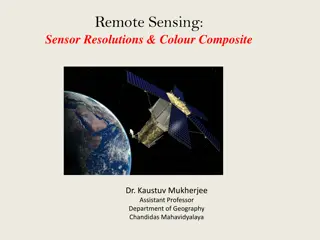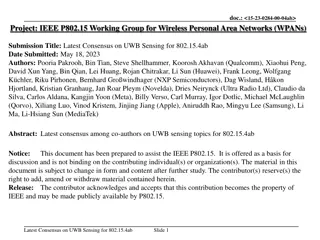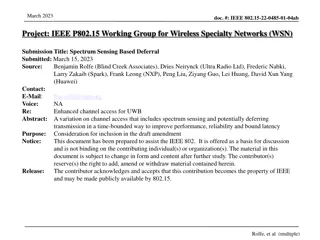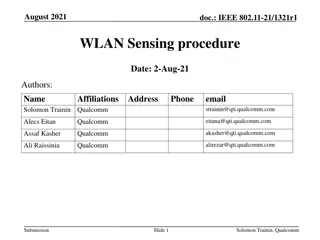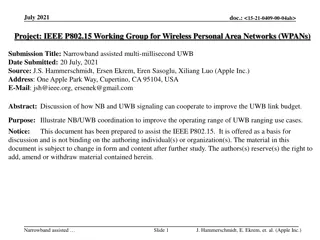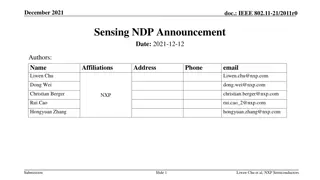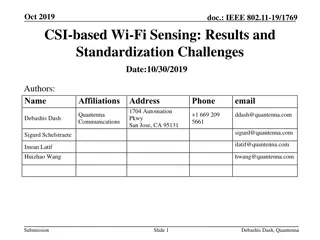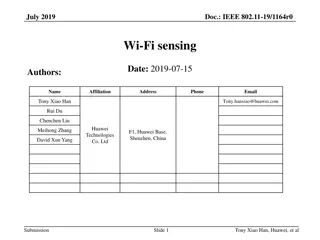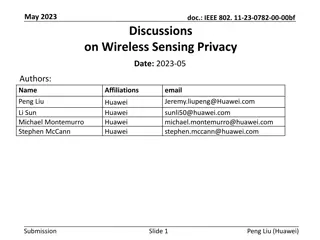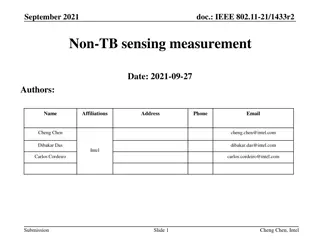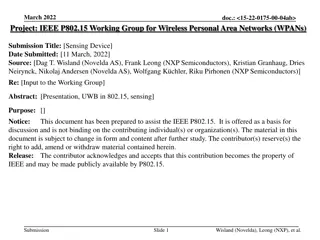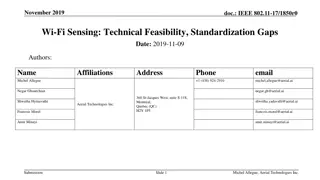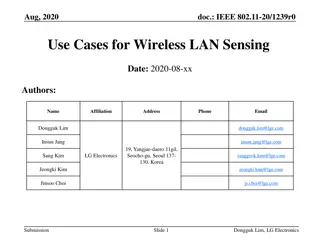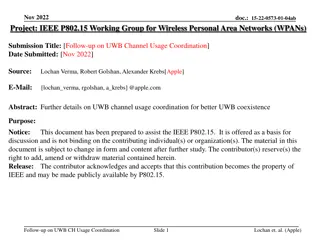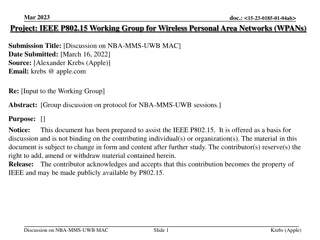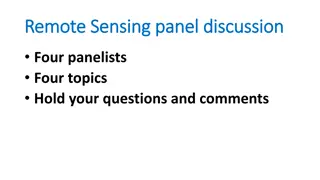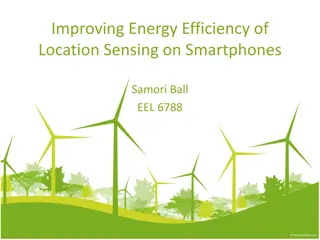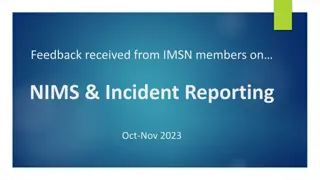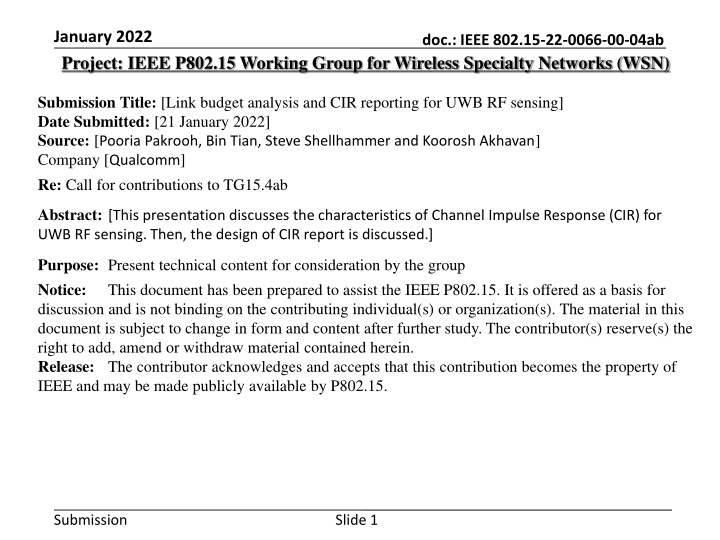
Channel Impulse Response Analysis for UWB RF Sensing
Discover the characteristics of Channel Impulse Response (CIR) for Ultra-Wideband (UWB) RF sensing and delve into CIR reporting design. Explore UWB RF sensing requirements, interference mitigation techniques, and improvements in link budget and air-time. Learn about advancements in accuracy, reliability, and power consumption for high-integrity ranging applications. Join the discussion on enhancing sensing capabilities for presence detection and environment mapping in wireless specialty networks.
Download Presentation

Please find below an Image/Link to download the presentation.
The content on the website is provided AS IS for your information and personal use only. It may not be sold, licensed, or shared on other websites without obtaining consent from the author. If you encounter any issues during the download, it is possible that the publisher has removed the file from their server.
You are allowed to download the files provided on this website for personal or commercial use, subject to the condition that they are used lawfully. All files are the property of their respective owners.
The content on the website is provided AS IS for your information and personal use only. It may not be sold, licensed, or shared on other websites without obtaining consent from the author.
E N D
Presentation Transcript
January 2022 Project: IEEE P802.15 Working Group for Wireless Specialty Networks (WSN) doc.: IEEE 802.15-22-0066-00-04ab Submission Title: [Link budget analysis and CIR reporting for UWB RF sensing] Date Submitted: [21 January 2022] Source: [Pooria Pakrooh, Bin Tian, Steve Shellhammer and Koorosh Akhavan] Company [Qualcomm] Re: Call for contributions to TG15.4ab Abstract:[This presentation discusses the characteristics of Channel Impulse Response (CIR) for UWB RF sensing. Then, the design of CIR report is discussed.] Purpose: Present technical content for consideration by the group Notice: This document has been prepared to assist the IEEE P802.15. It is offered as a basis for discussion and is not binding on the contributing individual(s) or organization(s). The material in this document is subject to change in form and content after further study. The contributor(s) reserve(s) the right to add, amend or withdraw material contained herein. Release: The contributor acknowledges and accepts that this contribution becomes the property of IEEE and may be made publicly available by P802.15. Submission Slide 1
January 2022 PAR Objective Safeguards so that the high throughput data use cases will not cause significant disruption to low duty-cycle ranging use cases Interference mitigation techniques to support higher density and higher traffic use cases Other coexistence improvement Backward compatibility with enhanced ranging capable devices (ERDEVs) Improved link budget and/or reduced air-time Additional channels and operating frequencies Improvements to accuracy / precision / reliability and interoperability for high-integrity ranging Reduced complexity and power consumption Hybrid operation with narrowband signaling to assist UWB Enhanced native discovery and connection setup mechanisms Sensing capabilities to support presence detection and environment mapping doc.: IEEE 802.15-22-0066-00-04ab Proposed Solution (how addressed) We investigate the characteristics of Channel Impulse Response (CIR) for UWB RF sensing. Then, the design of CIR report is discussed. Low-power low-latency streaming Higher data-rate streaming allowing at least 50 Mbit/s of throughput Support for peer-to-peer, peer-to-multi-peer, and station-to-infrastructure protocols Infrastructure synchronization mechanisms Submission Slide 2 P. Pakrooh et. al (Qualcomm)
January 2022 doc.: IEEE 802.15-22-0066-00-04ab Introduction RF sensing has different requirements than ranging and communication o Ranging relies on the estimation of earliest path in Channel Impulse Response (CIR). o Communication mostly utilizes the few strongest CIR taps. o RF sensing makes inferences about the changes in the environment by measuring changes in the wireless channel(s) and relies on channel consistency from one packet to the next. Sensing information may be contained in a window of CIR taps. Submission Slide 3 P. Pakrooh et. al (Qualcomm)
January 2022 doc.: IEEE 802.15-22-0066-00-04ab Introduction We investigate the channel impulse response (CIR) characteristics for RF sensing through link budget analysis. o The CIR taps could have low power and large dynamic range. The design of the sensing CIR report format should address these two challenges in RF sensing: o Large dynamic range in CIR taps o Consistency in CIR report for multiple CIR measurements to identify changes in the environment Based on the characteristics of CIR and sensing requirements, we share our thoughts on sensing report design. Submission Slide 4 P. Pakrooh et. al (Qualcomm)
January 2022 doc.: IEEE 802.15-22-0066-00-04ab Sensing link budget analysis Consider a bi-static UWB sensing scenario in which CIR measurement report is required. Here, we provide a UWB RF Sensing link budget based on the Radar Equation Based on that, we look at the dynamic range of the difference between the direct path and the reflected path off the object being sensed ?3 Initiator/ Tx Responder/Rx ?2 ?1 Sensing packet OTA CIR measurement report Object being sensed Submission Slide 5 P. Pakrooh et. al (Qualcomm)
January 2022 doc.: IEEE 802.15-22-0066-00-04ab Radar equation for UWB sensing Dynamic range and received power analysis, using standard radar equation ???= 4?3?1 ??? ??? ?2? ??? 2 ?2 2 Parameter Typical Value Notes ??? -14.3 dBm There is a regulatory limit of -41.3 dBm/MHz Using 500 MHz Bandwidth gives us a transmit power of -14.3 dBm ??? ??? ? 1 = (0 dBm) Omni Antenna with no Antenna Loss (Optimistic) 1 = (0 dBm) Omni Antenna with no Antenna Loss (Optimistic) 0.375 meters IEEE 802.15.4z states Ten frequency channels are available with center frequencies from 6489.6 MHz to 9945.6 MHz and various bandwidths. Here we use 8 GHz as the carrier frequency. ? 0.02 (hand), 0.2 (child), 1 (adult) in meters2 The actual radar cross section of sensing object. ?1 ?2 A few meters Depends on the application A few meters Depends on the application Submission Slide 6 P. Pakrooh et. al (Qualcomm)
January 2022 doc.: IEEE 802.15-22-0066-00-04ab UWB Sensing received power Received power vs object location for Tx/Rx distance of 5(m) o Far field radiation starts at d>2 ?2 Assuming d>5 : UWB Tx , where D is antenna dimension. UWB Rx o Heatmap colors represent received signal power from sensing objects placed at different locations o The near field region d<5 where the far field radiation assumption is invalid is omitted by white circles around Tx/Rx antennas. Slide 7 Submission P. Pakrooh et. al (Qualcomm)
January 2022 doc.: IEEE 802.15-22-0066-00-04ab UWB Sensing dynamic range Ratio of RX Power of direct path and RX Power of Reflected Path: Assuming d1=d2=d, Ratio Direct/Reflected received power increases according to ?2 Depending on the distance, the main challenges for UWB sensing are therefore large dynamic range and potentially low received signal level. o For example, at 5(m) Tx/Rx distance: Large dynamic range of 22-38dB, and weak received power of around -120 dBm at 5(m) sensing object distance Submission Slide 8 P. Pakrooh et. al (Qualcomm)
January 2022 doc.: IEEE 802.15-22-0066-00-04ab CIR Report In some RF Sensing applications, the channel impulse response (CIR) may need to be sent over-the-air from Responder to the Initiator [1, 2] A presentation on CIR report feedback has been provided in [3]. In the design of the CIR measurement report we need to address the large dynamic range and low level for CIR report. Specifically, CIR measurement report format needs to be decided: 1. Which CIR taps to be included in the report (approaches 1a-1c in this presentation) 2. Alignment of the CIR measurement report across packets 3. Feedback format for the CIR tap values Submission Slide 9 P. Pakrooh et. al (Qualcomm)
January 2022 doc.: IEEE 802.15-22-0066-00-04ab Approach 1a: Thresholding CIR taps Report the strongest tap, and the taps whose power are above a threshold. Challenges: o Needs careful selection of the threshold value, potentially relative to the strongest tap: For conservative selection of threshold, this could end up with large overhead. For large threshold, the object(s) of interest could be missed. o Leads to a variable length for the CIR measurement report o Non-uniform CIR samples This requires indication of tap offsets as well as the tap values. o Difficulty in comparing CIR reports across measurements, since reported taps could be different in different measurements. Submission Slide 10 P. Pakrooh et. al (Qualcomm)
January 2022 doc.: IEEE 802.15-22-0066-00-04ab Approach 1b: ? strongest CIR taps Top ? strongest taps are included in the CIR report, where ? is a parameter Challenges: o Needs careful selection of the value ? to report in various sensing conditions For small selection of ?, the sensing object of interest could be missed due to weak reflection For conservative selection of ?, this could end up with large overhead. o Leads to a variable length for the CIR measurement report o Non-uniform CIR samples This requires indication of tap offsets as well as the tap values. o Difficulty in comparing CIR reports across measurements, since reported taps could be different in different measurements. Submission Slide 11 P. Pakrooh et. al (Qualcomm)
January 2022 doc.: IEEE 802.15-22-0066-00-04ab Approach 1c: Fixed window duration in time domain Here we propose to use a CIR reporting window of fixed length. The duration of the window depends on the sensing distance spread to be covered o Note that this window needs to be large enough to capture the important CIR taps expected for the RF sensing application, needs to be adjustable depending on the application In this approach, the receiver needs a reference for which to define the CIR Window. Submission Slide 12 P. Pakrooh et. al (Qualcomm)
January 2022 doc.: IEEE 802.15-22-0066-00-04ab Approach 1c: Fixed window duration in time domain In this approach, the receiver needs a reference for the CIR window o Option 1: The strongest tap in the CIR: Fixed duration around the strongest tap; this is possibly the most consistent marker we can get. Strongest detected tap Noise Threshold ?0- ????? ?0+ ???? ?0 Fixed window around the strongest detected tap o Option 2: Earliest detected tap: For example, in [3] it was suggested to start the CIR reporting window with the first detected tap Earliest detected tap Noise Threshold ?0- ????? ?0+ ???? ?0 Fixed window around the earliest detected tap No significant different between two options. Strongest tap as a reference may be more consistent, and easy to define. The earliest tap can be weak, and its detection is implementation specific. Slide 13 Submission P. Pakrooh et. al (Qualcomm)
January 2022 doc.: IEEE 802.15-22-0066-00-04ab Approach 1c: Fixed window duration in time domain If LOS is not blocked, potentially the strongest tap is close to the first tap. Therefore, the window could be selected asymmetrically around the strongest tap. Signaling from initiator to responder could be used on how many taps to report before/after the strongest tap (parameterized as ????? and ???? in the figure below). The benefits of the proposed approach: o As the window length is fixed, this approach does not need much processing at the responder to identify the taps for the CIR report. o This does not require indication of tap offset since the taps are reported in order. Submission Slide 14 P. Pakrooh et. al (Qualcomm)
January 2022 doc.: IEEE 802.15-22-0066-00-04ab Analysis on feedback size for approach 1c Depending on the sensing range under coverage, the number of required taps can be computed as: ??????? ?? ?? ? , where ??????? is the sensing range spread to be covered in the sensing application: Difference between the shortest and longest paths in the sensing application: that is, ???????= ?1+ ?2- ?3in the figure below o ??????= ?3 Initiator/ Tx Responder/Rx ?1 ?2 Object being sensed Submission Slide 15 P. Pakrooh et. al (Qualcomm)
January 2022 doc.: IEEE 802.15-22-0066-00-04ab Analysis on feedback size for approach 1c Example: 16 taps at chip rate (2ns) or 32 taps at 2x chip rate (1ns) can cover sensing range spread close to 10 (m) o At ??????? greater than 10(m) the signal level drops very low. See slide 7. CIR report duration: Here, for simplicity we assume 16 bits for each I/Q to achieve dynamic range of 90 dB. Further compression is possible. o At 2x chip rate sampling, total number of bits: 32bits*32=128 bytes o 128 bytes per 10m of coverage at 2x chip rate Sensing range spread (m) # of taps at twice chip rate (1ns) Feedback size (bytes) HPRF CIR feedback duration (us) BPRF CIR feedback duration (us) 5 16 64 18.75 75 10 32 128 37.5 150 Submission Slide 16 P. Pakrooh et. al (Qualcomm)
January 2022 doc.: IEEE 802.15-22-0066-00-04ab CIR report alignment across packets As discussed, RF Sensing makes inferences about the changes in the environment by measuring changes in the wireless channel. In the fixed widow approach (1c), each packet is reported with the reference point as either strongest tap or earliest detected tap. o Across multiple packets, if reference point [strongest or earliest in the standard] is kept consistent and the reference point does not change, then the packets are roughly aligned. Post-processing methods for further fine alignment can be left to implementation. o If there is change on the reference point, strongest or earliest tap, across different packets, the report window may have a mis-alignment. The window size can be selected large enough so that there is margin to compensate for mis-alignment. Implementation specific post-processing is required at application layer to further align the CIR windows across packets. Submission Slide 17 P. Pakrooh et. al (Qualcomm)
January 2022 doc.: IEEE 802.15-22-0066-00-04ab CIR value feedback format Feedback sampling rate: 2x of the UWB chip rate (998.4MHz) to achieve proper resolution for interpolation. Feedback format for CIR values needs to be specified in the standard o IQ domain: In-phase and quadrature CIR value The CIR values can be compressed before reporting. Submission Slide 18 P. Pakrooh et. al (Qualcomm)
January 2022 doc.: IEEE 802.15-22-0066-00-04ab Summary The CIR for RF sensing applications has large dynamic range and potentially low power. We recommend a window of fixed duration for the CIR measurement report in UWB sensing (approach 1c). o The duration of the window depends on the sensing distance spread to be covered. o The strongest or the earliest detected CIR tap was proposed as the reference for defining the CIR Window o This does not require indication of tap offset since the taps are reported in order. o The overhead of the report is reasonable. Submission Slide 19 P. Pakrooh et. al (Qualcomm)
January 2022 doc.: IEEE 802.15-22-0066-00-04ab References 1. Frank Leong, Wolfgang K chler, Riku Pirhonen, UWB Sensing in 802.15, IEEE 802.15-21/399r0, July 2021 2. Pooria Pakrooh, Bin Tian, Steve Shellhammer, and Koorosh Akhavan UWB Sensing Scenarios for 802.15.4ab , IEEE 802.15-22-0012-01-4ab, January 2022 3. Xiaohui Peng, David Xun Yang, Chenchen Liu, Rani Keren, Kuan Wu, CIR feedback for UWB sensing, IEEE 802.15-21/570r0, November 2021 4. R1-2112493, 3GPP TSG RAN WG1 #107-e, Feature Lead Summary #2 for Potential multipath/NLOS mitigation , Moderator (Nokia) Submission Slide 20 P. Pakrooh et. al (Qualcomm)

